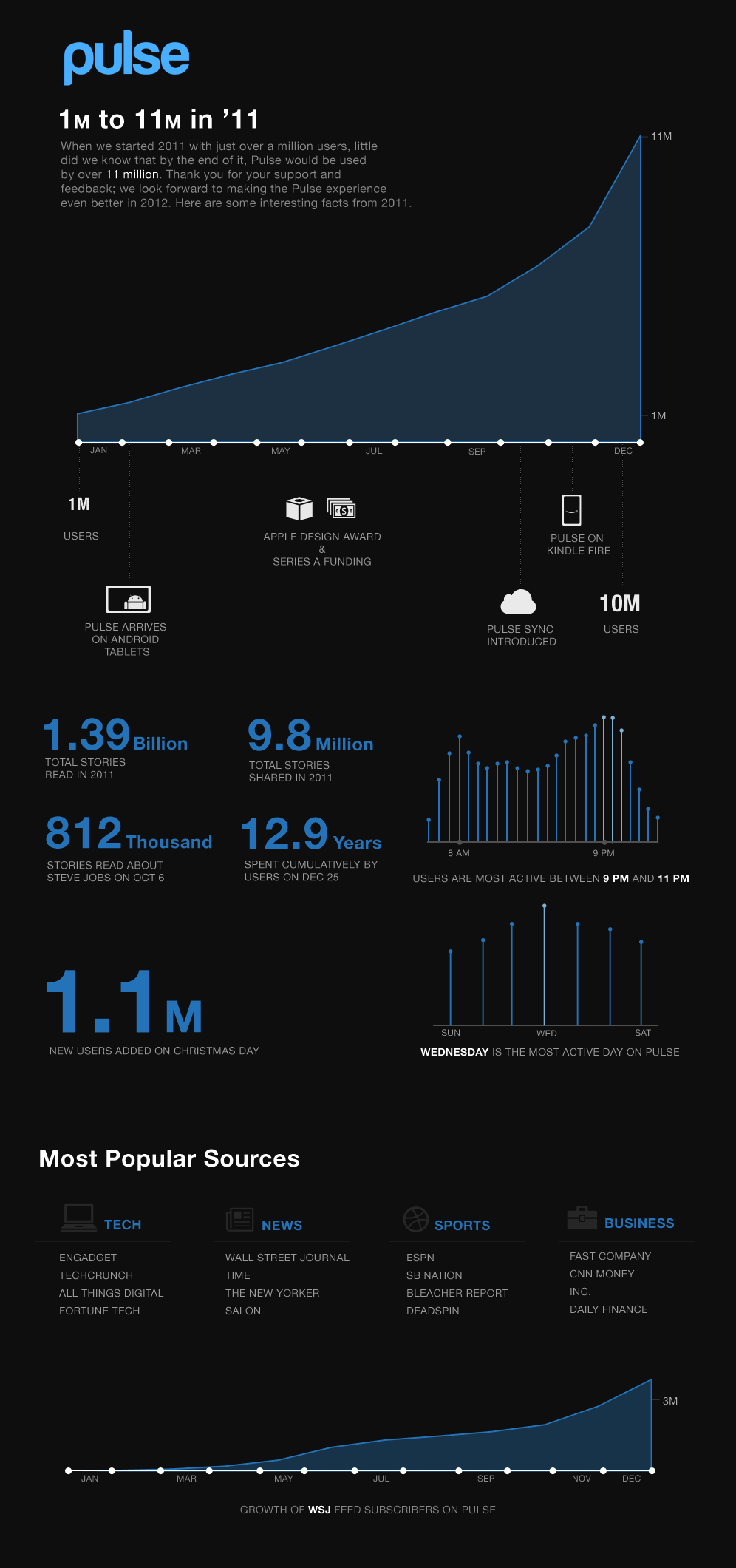In November, Amazon began shipping its new Kindle. At the time, even though reactions were varied, though Amazon hoped for the best, as some projected it would sell as many as 5 million by the end of 2011. Though the indications are that it didn’t get there. However, the media hype and early Kindle sales have still been a boon for a young startup that you’re probably by now familiar with: Pulse.
At launch in November, the suped up RSS-style news reader tailored for mobile devices found itself the unofficial news reader for the Kindle Fire. While Amazon never officially endorsed them as such, Pulse was one of a handful of native apps to appear on the device’s homescreen right out of the box. Of course, Amazon keeps their cards close to their chest, like Apple, and Pulse Co-founder Akshay Kothari tells me that the team didn’t know Amazon had chosen them as such until a few weeks before the device was shipped.
In fact, the Kindle Fire’s sales saw Pulse rack up 1.1 million downloads on Christmas Day alone. Of course, this is aided by the fact that the newsreader app has been both lucky and fleet with pushing designs early on emerging platforms. Steve Jobs mentioned Pulse at the iPad launch event, and although Pulse was subsequently pulled, it started a trend. The app went on to see a lot of adoption on the iPad, and caught fire on Honeycomb (as much as an app can), and has leveraged that early success to secure such optimal placement on the Kindle.
Kothari today shared with TechCrunch that over the course of 2011, Pulse went from 1 million downloads to over 11 million, and are currently averaging approximately one download every two seconds, and 1.5 million every month. Of course, downloads are one thing, active users another. Pulse isn’t ready to share active users numbers, presumably because they aren’t particularly close to the downloads statistics, but people are using it. For example, in total, users have read a total of 1.39 billion stories through Pulse, and shared 9.8 million stories. As a note of tribute to Steve Jobs, 812K stories were read about the Apple co-founder on October 6th.
The app has seen high adoption for several reasons, and part of that is hanks to its touch-based interface (easy swiping/scrolling), clean design, and visual appeal. But, it’s also the fact that it’s been able to strike a number of strategic partnerships with big media outlets, like ESPN, and with deal sites like Groupon. (Pulse now has over 250 publishing partners.)
And, as a word to wise entrepreneurs, Kothari tells me that the success has also been attributable to the fact that the team is on all of the major platforms, iPhone, iPad, Android, Android tablets, Nook, Amazon, Windows Phone 7, etc. Focusing on building apps for each OS and mobile experience is important, and giving readers the ability to sync their Pulse apps across platforms was a big move for Pulse. Kothari says that the key, while difficult to always implement effectively, is to maintain a consistency of brand across mobile platforms, while optimizing apps for each of their particular experiences.
Like others before, he said that the experience building for each is different, but that iOS makes it easy to prototype different looks, there’s a lack of fragmentation, only one screensize for the iPad and iPhone, and they have great tools. The benefit to Android is scale and the quick turnaround cycle. “Mobile hasn’t seen a great A/B testing formula,” Kothari says, but Android gets the closest. Amazon, on the other hand, has done a pretty good job of making it easy for Android developers to build apps for their modified mobile OS. Windows Phone? Well, that remains to be seen.
Pulse has seen some great competition from Flud, which hasn’t seen nearly the same scale and adoption Pulse has managed thanks to its great distribution plays, but it’s trying to push forward the socialization (so to speak) of the newsreading experience.
Because it was a fast-paced, hockey-stick-growth type year for Pulse, the focus was mainly on scaling. But the co-founder said that they’re getting to a point where they feel comfortable with their progress there and are ready to focus more on the social aspects of news, as well as productizing their experience. And, hey, with Streamglider, Taptu, and others, there’s plenty of competition to go around.
They’ve been able to get pretty far with their Palo Alto-based team of 20, but they’re ramping up in their hiring thanks to that $9 million round in June in hopes of doing more with the reams of data they’ve been collecting around what people are reading. There’s a lot of potential around this, just as we’ve seen publishing companies launching news apps on Facebook to get in the news feed, Pulse is looking for the best ways to encourage social news sharing. And as something that’s already, in my opinion, social, there’s plenty of opportunity.
For more, check out Pulse’s stats in their infographic below:

